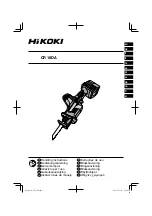
15
POWER SWITCH
See Figure 12.
Your table saw is equipped with a power switch
that has a built-in locking
feature. This feature is intended to prevent
unauthorized and possible
hazardous use by children and others.
TO TURN YOUR SAW ON:
∙
With the switch key inserted into the switch, lift
the switch button to turn ON.
TO TURN YOUR SAW OFF:
∙
Press the switch button down to turn OFF.
TO LOCK YOUR SAW:
∙
With the saw turned OFF, pull the switch key
from the switch and store in a safe, secure
location.
Overload protection
WARNING:
To prevent an accidental startup if
the overload reset switch
is pushed, the on/off switch should be in the OFF
position, and the plug
should be removed from the power source while
cool-down takes place.
Overheating may be caused by misaligned parts
or a dull blade. Inspect your saw for proper setup
before using it again.
This saw has an overload reset switch (1) that
will restart the motor after it shuts off due to
overloading or low voltage. If the motor stops
during operation:
1.Turn the ON/OFF switch to the OFF position.
2.Wait about five minutes for the motor to cool.
3.Push in on the overload reset switch.
4.Turn the switch to the ON position.
TO CHANGE THE BLADE DEPTH
See Figure 13.
The blade depth should be set so that the outer
tips of the blade are higher
than the workpiece by approximately 1/8 in. to
1/4 in. but the lowest points
(gullets) are below the top surface. Raise the
blade by turning the blade adjusting
handle counterclockwise or lower it by turning
the handle clockwise.
TO CHANGE BEVEL ANGLE
See Figure 14.
A 90° cut has a 0° bevel and a 45° cut has a 45°
bevel.
∙
Unplug the saw.
∙
Loosen bevel control by turning bevel lock lever
all the way to the left. If it needs
to be further loosened, pull spring-loaded bevel
lock lever out and rotate it back to
the right. Release bevel locking lever and allow it
to seat (lock) in its original position.
Turn it to the left again until loose.
∙
Adjust the bevel angle by sliding the blade
adjusting handle left or right to the
desired angle.
∙
Tighten bevel control by turning bevel lock lever
to the right. If it needs to be
tightened more, pull the spring-loaded bevel lock
lever out and rotate it to the left.
Then release bevel lock lever and allow it to
return to its original position. Rotate to
the right again. Repeat this process until bevel
lock lever is securely tightened.
NOTE:
Before cutting, the bevel lock lever must be
securely locked as shown in
figure 16.
TO ADJUST THE BEVEL INDICATOR
See Figure 15.
If the bevel indicator is not at zero when the saw
blade is at 90°, adjust the indicator
by loosening the screw and setting it at 0° on the
bevel scale. Retighten the screw.
WARNING:
To reduce the risk of injury,
alwaysmake sure the rip fence is parallel to
the blade before beginning any operation.
TO INSTALL THE RIP FENCE
See Figure 16.
∙
Place the rear lip on the rear of the saw table
and pull slightly toward the front of the unit.
∙
Lower the front end of the rip fence onto the
Summary of Contents for 59695035
Page 2: ...2 E K R M N FIG 2 FIG 1 H I J C F G L P B A D O Q ...
Page 6: ...6 2 3 4 1 6 11 10 13 12 14 15 8 5 7 9 ...
Page 23: ...23 10 TABLE SAW MODEL NO JF72553B SCHEMATIC ...
Page 24: ...24 142 143 144 56 63 145 30 56 144 168 10 TABLE SAW MODEL NO JF72553B ...
Page 41: ...41 BANC DE SCIE 10 PO MODÈLE N JF72553B Schéma ...
Page 42: ...42 142 143 144 56 63 145 30 56 144 168 BANC DE SCIE 10 PO MODÈLE N JF72553B Schéma ...
















































